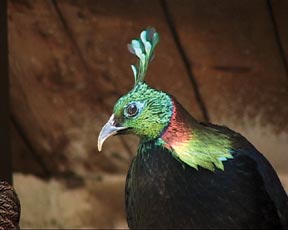By Dr. Susan Sharma
The beautiful monal pheasant , 'the bird of nine colours', is the state bird for both Himachal Pradesh and Uttaranchal. It is also the national bird of Nepal. The Himalayan monal, an endangered species as per the IUCN Red Data Book, is included
in Schedule I of the Wildlife (Protection) Act, 1972. It is found in all the Himalayan states, Jammu & Kashmir, Himachal Pradesh, Uttaranchal, Sikkim and Arunachal Pradesh.
Generally found in the forested areas between 2,000m and 3,500 meters, the monal inhabits alpine and sub-alpine tracts during summer and descends to lower altitudes in winter, specially during heavy snow fall. The birds dig for tubers and roots with their powerful
beaks. Their main diet, apart from tubers and roots is seeds, berries and insects.
 Males are normally seen with more than one female. The main call of the male bird is like a flute whistle, heard often at dawn during the breeding season.
Males are normally seen with more than one female. The main call of the male bird is like a flute whistle, heard often at dawn during the breeding season.
The male monal displays gorgeous plumage and has a prominent crest on its head. The crest and head of intensely brilliant, burnished green colour; back of the neck is burnished copper red/golden green depending on light conditions. The upper
part of the back is bronze green, the lower, is silver white, concealed by metallic purple wings. During courtship, the cock fans and raises his rufous tail, droops his wings to reveal the white back patch, and fluffs out brilliant iridescent neck feathers.
The female is mottled light brown with a short tuft on the head and a white throat. The bare skin around the eye is bluish. Eggs are laid in rudimentary nests on the ground or under boulders during May -June. Incubation period is about 28
days.
The main threat to monal as well as other ground nesting pheasants is the occurrence of forest fires. Hunting and trapping for local consumption/ plumage is the other major threat. .
( Photograph of monal by Dr.Susan Sharma)